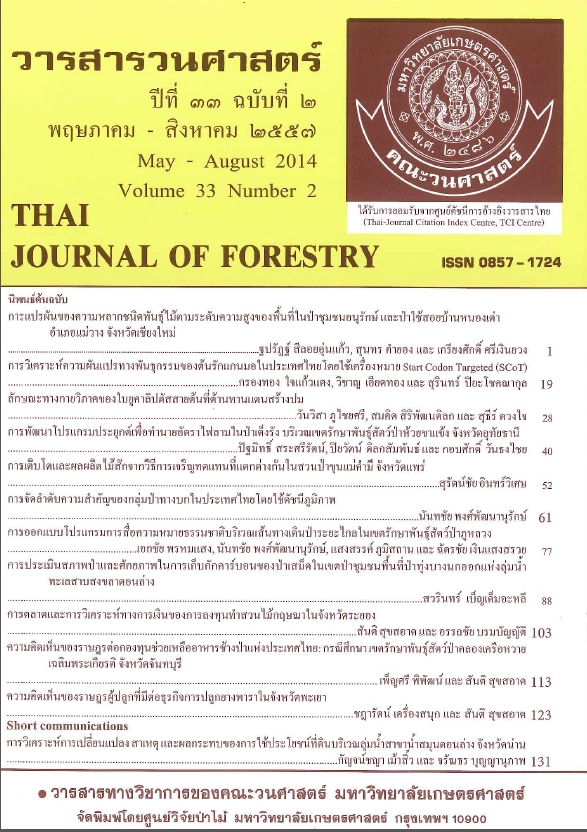การแปรผันของความหลากชนิดพันธุ์ไม้ตามระดับความสูงของพื้นที่ ในป่าชุมชนอนุรักษ์ และป่าใช้สอยบ้านหนองเต่า อำเภอแม่วาง จังหวัดเชียงใหม่
Main Article Content
บทคัดย่อ
การศึกษาการแปรผันของความหลากชนิดพันธุ์ไม้ตามระดับความสูงของพื้นที่ในป่าชุมชนอนุรักษ์และป่าใช้สอย บ้านหนองเต่า อำเภอแม่วาง จังหวัดเชียงใหม่ โดยใช้วิธีวิเคราะห์สังคมพืช ทำการวางแปลงสุ่มตัวอย่างขนาด 40 x 40 เมตร ประเภทป่าละ 50 แปลง รวม 100 แปลง ให้กระจายแบบสุ่มครอบคลุมพื้นที่ป่าที่ความสูง 1,000-1,800 เมตร จากระดับน้ำทะเล ในทุกแปลง ทำการวัดเส้นรอบวงลำต้นที่ความสูง 1.3 เมตรจากพื้นดิน (ขนาดวัดรอบเพียงอก) ความกว้างเรือนยอดและความสูงพันธุ์ไม้ทุกต้นที่สูง >1.5 เมตร พบพันธุ์ไม้ในป่าอนุรักษ์ทั้งหมด 256 ชนิด (166 สกุล 73วงศ์) และป่าใช้สอย 132 ชนิด (93 สกุล 52 วงศ์) พันธุ์ไม้เด่นในป่าอนุรักษ์ คือ สนสามใบ ทะโล้ ก่อแป้น ก่อขาวและก่อเดือย พบพันธุ์ไม้วงศ์ Fagaceae มากที่สุด (21 ชนิด) รองลงมา คือ Euphorbiaceae และ Leguminosae (16 ชนิด) Rubiaceae (15 ชนิด) และ Lauraceae (12 ชนิด) สนสามใบมีค่าความถี่ 58 เปอร์เซ็นต์ จึงมีแนวโน้มเป็นป่าสนผสมป่าดิบเขาต่ำและอีก 42 เปอร์เซ็นต์ มีแนวโน้มเป็นป่าดิบเขาต่ำ มีความหนาแน่นต้นไม้เฉลี่ย 314+2.78 ต้นต่อไร่ สนสามใบมีดัชนีความสำคัญมากที่สุด รองลงมาคือ ทะโล้ ก่อแป้น ก่อขาว แข้งกวางและกำยาน ตามลำดับ มีค่าดัชนีความหลากชนิดต่อแปลงเฉลี่ย 4.49+0.64 และดัชนีบ่งชี้สภาพป่า 17.3+6.87 ในป่าใช้สอย พบพันธุ์ไม้วงศ์ Fagaceae มากที่สุด (16 ชนิด) รองลงมา คือ Euphorbiaceae และ Rubiaceae (10 ชนิด) และ Lauraceae (6 ชนิด) สนสามใบมีค่าความถี่ 98 เปอร์เซ็นต์ ซึ่งมีแนวโน้มเป็นป่าสนผสมป่าดิบเขา เหลือเพียง 2 เปอร์เซ็นต์ ที่มีแนวโน้มเป็นป่าดิบเขา มีความหนาแน่นต้นไม้เฉลี่ย 388+9.82 ต้นต่อไร่ ก่อหมากมีค่าดัชนีความสำคัญมากที่สุดในป่า รองลงมาคือ สนสามใบ เคาะและก่อเดือย ตามลำดับ มีค่าดัชนีความหลากชนิด 3.43+0.50 และดัชนีบ่งชี้สภาพป่า 10.54+4.60 พันธุ์ไม้เขตร้อนมีการกระจายขึ้นไปและลดจำนวนประชากรลงตามความสูงพื้นที่ พันธุ์ไม้เขตอบอุ่นขึ้นอยู่มากตามยอดเขาสูงที่เป็นป่าอนุรักษ์และน้อยลงในป่าใช้สอย จำนวนชนิดพันธุ์ สกุลและวงศ์ไม้ ดัชนีความหลากชนิด พื้นที่หน้าตัดลำต้นและการปกคลุมเรือนยอดในป่าอนุรักษ์มีมากกว่าป่าใช้สอย โดยมีการแปรผันตามความสูงของพื้นที่ สภาพป่าดั้งเดิมที่แตกต่างกันและการใช้ประโยชน์จากป่าโดยการตัดฟันไม้ในป่าใช้สอยทำให้ความหลากชนิดของพันธุ์ไม้น้อยกว่าป่าอนุรักษ์
คำสำคัญ: ป่าชุมชน ความหลากชนิดพันธุ์ไม้ ป่าดิบเขา การกระจายพันธุ์ไม้ตามความสูงพื้นที่
Downloads
Article Details

อนุญาตภายใต้เงื่อนไข Creative Commons Attribution-NonCommercial-NoDerivatives 4.0 International License.
ข้าพเจ้าและผู้เขียนร่วม (ถ้ามี) ขอรับรองว่า ต้นฉบับที่เสนอมานี้ยังไม่เคยได้รับการตีพิมพ์และไม่ได้อยู่ในระหว่างกระบวนการพิจารณาตีพิมพ์ลงในวารสารหรือสิ่งตีพิมพ์อื่นใด ข้าพเจ้าและผู้เขียนร่วม (ถ้ามี) ยอมรับหลักเกณฑ์และเงื่อนไขการพิจารณาต้นฉบับ ทั้งยินยอมให้กองบรรณาธิการมีสิทธิ์พิจารณาและตรวจแก้ต้นฉบับได้ตามที่เห็นสมควร พร้อมนี้ขอมอบลิขสิทธิ์ผลงานที่ได้รับการตีพิมพ์ให้แก่วารสารวนศาสตร์ คณะวนศาสตร์ มหาวิทยาลัยเกษตรศาสตร์ กรณีมีการฟ้องร้องเรื่องการละเมิดลิขสิทธิ์เกี่ยวกับภาพ กราฟ ข้อความส่วนใดส่วนหนึ่ง หรือ ข้อคิดเห็นที่ปรากฏในผลงาน ให้เป็นความรับผิดชอบของข้าพเจ้าและผู้เขียนร่วม (ถ้ามี) แต่เพียงฝ่ายเดียว และหากข้าพเจ้าและผู้เขียนร่วม (ถ้ามี) ประสงค์ถอนบทความในระหว่างกระบวนการพิจารณาของทางวารสาร ข้าพเจ้าและผู้เขียนร่วม (ถ้ามี) ยินดีรับผิดชอบค่าใช้จ่ายทั้งหมดที่เกิดขึ้นในกระบวนการพิจารณาบทความนั้น”


